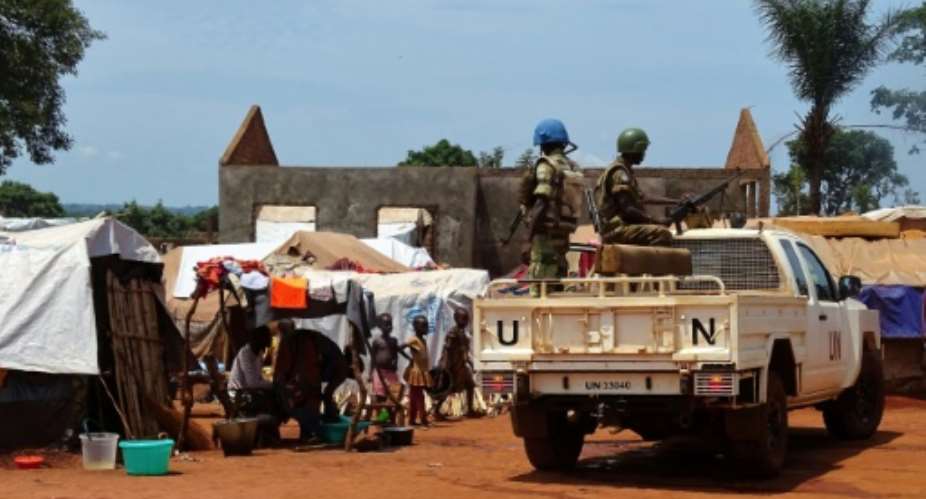Bangui (Central African Republic) (AFP) - The government of the Central African Republic on Monday signed an "immediate ceasefire" deal with rebel groups aimed at ending violence in the strife-torn country.
One of the world's poorest nations, the landlocked Central African Republic has been struggling to recover from a three-year civil war between the Muslim and Christian militias that started after the 2013 overthrow of leader Francois Bozize.
In March, the country came in last of 155 nations surveyed in the annual World Happiness Report.
History of instability
In June UN Secretary General Antonio Guterres voiced concern over the "widespread instability" and attacks on UN troops in the CAR, after a month of renewed violence which forced tens of thousands to flee conflict-ravaged areas.
In fact the country has enjoyed little peace or stability since gaining its independence from France in 1960.
Five years later president David Dacko was ousted by Jean-Bedel Bokassa, who took charge in January 1966 and crowned himself emperor in 1977 in a wildly extravagant ceremony that made waves around the world.
His reign was marked by bloodshed, notably the 1979 massacre of school children who refused to buy school uniforms from a firm owned by one of his wives.
The French drove Bokassa out on September 20, 1979, while he was on a visit to Libya. Dacko was reinstated, but two years later forced to hand power over to senior military officers.
A multi-party system was unveiled in 1991, but then three mutinies in 1996-97 were followed by a failed coup in 2001.
Bozize, a former military chief, rebelled and took over in 2003. Several more rebellions followed and France intervened with help from Chadian soldiers in November 2006 to recapture towns in the north that had fallen to rebel forces.
Bozize was re-elected in 2011, though the vote was marred by fraud, but he was overthrown in March 2013 by mostly Muslim rebels from the Seleka coalition, who were in turn ousted a year later by a military intervention led by former colonial ruler France.
Those events sparked the bloodiest sectarian violence in the country's history as mainly Christian militias sought revenge against their Muslim foes.
Christians who account for about 80 percent of the population organised vigilante units dubbed "anti-balaka", in reference to the machetes used by the rebels.
Poverty
The Central African Republic is rich in natural resources, including diamonds, uranium, timber, gold and oil
However, the chronic crises have greatly harmed key sectors, and economic activity now comprises mainly subsistence agriculture.
Almost 70 percent of the country's 4.8 million inhabitants live in poverty, and in 2015 the World Bank estimated per capita income at $330 (285 euros), making it one of the world's poorest countries.
Administrations have been paralysed by the unrest, and the customs, tax and public treasury services are unable to collect funds needed to pay salaries and pensions.
Gross domestic product (GDP) plunged by 36 percent amid the unrest in 2013, but managed to expand by a slight 1.0 percent in 2014.
However, an International Monetary Fund report last month projected economic growth at 4.7 percent "assuming the ongoing dialogue with armed groups helps to reduce violence, and public and private investment rebound".
Armed forces
The country's armed forces are estimated to number about 8,000, backed up by 900 French troops and an 10,000-strong UN force dubbed MINUSCA.
They have stabilised the situation, but do not control the entire country, which covers almost 623,000 square kilometres (241,000 square miles) -- a little less than Afghanistan or Chile.





 Election 2024: Don’t be complacent, we haven’t won yet – Asiedu Nketia cautions ...
Election 2024: Don’t be complacent, we haven’t won yet – Asiedu Nketia cautions ...
 Election 2024: Stop fighting over positions in Mahama’s next govt – Asiedu Nketi...
Election 2024: Stop fighting over positions in Mahama’s next govt – Asiedu Nketi...
 Prof Jane Naana Opoku-Agyemang will restore dignity of vice presidency – Fifi Kw...
Prof Jane Naana Opoku-Agyemang will restore dignity of vice presidency – Fifi Kw...
 'Ghana beyond aid' has turned out to be 'Ghana without compass' – Naana Opoku-Ag...
'Ghana beyond aid' has turned out to be 'Ghana without compass' – Naana Opoku-Ag...
 Nation builder Mahama will deliver on his promise of a 24-hour economy for the b...
Nation builder Mahama will deliver on his promise of a 24-hour economy for the b...
 Prof Jane Naana is more than qualified to be Ghana’s first vice president and ev...
Prof Jane Naana is more than qualified to be Ghana’s first vice president and ev...
 WENDA petitions Akufo-Addo, Speaker of Parliament to make vote-buying illegal
WENDA petitions Akufo-Addo, Speaker of Parliament to make vote-buying illegal
 Supreme court declares payment of wages to spouses of President, Vice President ...
Supreme court declares payment of wages to spouses of President, Vice President ...
 Publish full KPMG report on SML-GRA contract – Bright Simons to Akufo-Addo
Publish full KPMG report on SML-GRA contract – Bright Simons to Akufo-Addo
 Kumasi International Airport to begin full operations by end of June
Kumasi International Airport to begin full operations by end of June
